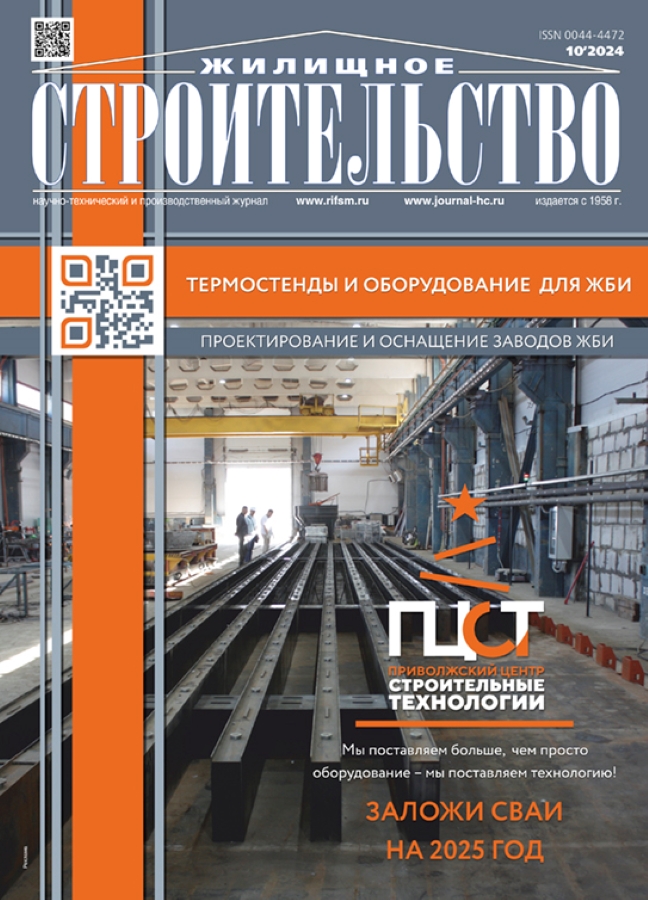Stages in the development of the architectural typology of panel residential buildings in Nizhny Novgorod
- Authors: Krasavina I.S.1
-
Affiliations:
- Nizhny Novgorod State University of Architecture and Civil Engineering
- Issue: No 10 (2024)
- Pages: 28-36
- Section: Articles
- URL: https://rjmseer.com/0044-4472/article/view/641756
- DOI: https://doi.org/10.31659/0044-4472-2024-10-28-36
- ID: 641756
Cite item
Abstract
The historical stages of the development of housing panel construction in Nizhny Novgorod (from October 7, 1932 to October 22, 1990 – Gorky) are considered. The periods of the series are highlighted: from the 1950s to the mid-1960s; from the mid-1960s to the mid-1970s; from the middle. 1970s to the late 1970s; from the 1980s to the 1990s; from the early 2000s to the mid-2020s.The application of standard projects of a series of residential buildings is analyzed, the transformation of their planning structure and appearance is revealed.The article considers such common series and their variations as 1-464 A, 1-464A-20 And, 1-464D, 1-464 H, 1-464 DM, E-600. Conclusions are drawn about changes in the planning structure: improvement of the dimensions of rooms, increase in the area of kitchens, introduction of separate bathrooms, change in the predominant number of rooms in the apartment, the appearance of a studio apartment.The tendency to increase the number of floors, the transformation of the silhouette, the use of decorative elements on the facade and the rejection of them, the strengthening of the role of glass and the color scheme of the facade is revealed.In the urban planning aspect, there has been a change in the main urban development unit from a microdistrict to a residential complex.The analysis noted both a decrease in the rate of construction of panel residential buildings at the end of the twentieth century, and the stimulation of further development of panel housing construction in Nizhny Novgorod at the beginning of the XXI century.
Full Text
About the authors
I. S. Krasavina
Nizhny Novgorod State University of Architecture and Civil Engineering
Author for correspondence.
Email: krasavinairina93@gmail.com
Postgraduate Student
Russian Federation, 65, Ilyinskaya street, Nizhny Novgorod, 603000References
- Cherkasov G.N. Khrushchev’s Thaw and the “Revival of architecture”, a seminar for young people of Moscow’s creative unions in Krasnaya Pakhra in 1965. Arkhitektura i stroitel’stvo Rossii. 2022. No. 1 (241), pp. 108–111. (In Russian).
- Kazakova O.V. On the origins of typical panel housing construction in the USSR. Zhilishchnoe Stroitel’stvo [Housing Constructions]. 2008. No. 11, pp. 13–18. (In Russian).
- Zolotareva M.V., Ponomarev A.V. The formation of industrial housing construction. The end of the 1950s – 1960s. The Leningrad experience. Zhilishchnoe Stroitel’stvo [Housing Constructions]. 2021. No. 10, pp. 19–26. (In Russian). https://doi.org/10.31659/0044-4472-2021-10-19-26
- Gorshkov A.S., Voilokov I.A., Orlovich R.B. Modernization of buildings of the first mass series. Zhilishchnoe Stroitel’stvo [Housing Constructions]. 2024. No. 3, pp. 26–34. (In Russian). https:// doi.org/10.31659/0044-4472-2024-3-26-34
- Pilipenko I.V. Zhilishchnoe stroitel’stvo v respublikakh SSSR za 70 let: Makroanaliz [Housing construction in the republics of the USSR over 70 years: Macroanalysis]. Moscow: Nauchnaya biblioteka. 2023. 600 p.
- Hess D.B., Tammaru T. Housing estates in the Baltic countries. The Legacy of central planning in Estonia, Latvia and Lithuania. Springer Open. 2019. 383 p. https://doi.org/10.1007/978-3-030-23392-1
- Fotin O.V. Construction of multi-storey buildings made of precast reinforced concrete. Zhilishchnoe Stroitel’stvo [Housing Constructions]. 2022. No. 10, pp. 19–22. (In Russian). https://doi.org/10.31659/0044-4472-2022-10-19-22
- Orlova N.G. Transformation of the architectural appearance of the residential environment in the industrial areas of the 60–80-ies of the twentieth century (on the example of Naberezhnye Chelny). Arkhitektura i stroitel’stvo Rossii. 2022. No. 2 (242), pp. 70–75. (In Russian).
- Basukinskaya E.V. Space-planning solutions for sectional multi-apartment residential buildings in a block-by-block development. Zhilishchnoe Stroitel’stvo [Housing Constructions]. 2019. No. 8, pp. 35–39. (In Russian). https://doi.org/10.31659/0044-4472-2019-8-35-39
- Blaginykh E.A., Stolboushkin A.Yu., Cherednichenko J.M. Design features and methods of preservation of objects of the Modernist era. Zhilishchnoe Stroitel’stvo [Housing Constructions]. 2021. No. 10, pp. 33–40. (In Russian). https://doi.org/10.31659/0044-4472-2021-10-33-40
- Gelfond A.L., Dutsev M.V. Large-panel building in the center of Nizhny Novgorod as an element of the historical and architectural environment. Arkhitektura i stroitel’stvo Rossii. 2023. No. 3 (247), pp. 28–33. (In Russian).
- Mikheev D.V., Guryev V.V., Dmitriev A.N., Bachurina S.S., Yakhkind S.I. Development of industrial civil engineering and standard design at the present stage. Zhilishchnoe Stroitel’stvo [Housing Constructions]. 2022. No. 7, pp. 41–52. (In Russian). https://doi.org/10.31659/0044-4472-2022-7-41-52
- Orel’skaya O.V. Modern panel residential buildings in Nizhny Novgorod. Zhilishchnoe Stroitel’stvo [Housing Constructions]. 2019. No. 10, pp. 32–37. (In Russian). https://doi.org/10.31659/0044-4472-2019-10-32-37
- Nikolaev S.V. Monolithic panel low-rise buildings. Zhilishchnoe Stroitel’stvo [Housing Constructions]. 2022. No. 3, pp. 8–15. (In Russian). https:// doi.org/10.31659/0044-4472-2022-3-8-15
- Guryev V.V., Dmitriev A.N., Yakhkind S.I. Experimental and standard design – a strategic vector of development of industrial civil construction. Promyshlennoe i gragdanskoe stroitelstvo. 2022. No. 7, pp. 40–47. (In Russian). https:// doi.org/10.33622/0869-7019.2022.07.40-47
- Sokolov N.S. Technology for increasing the bearing capacity of the base. Stroitel’nye Materialy [Construction Materials]. 2019. No. 6, pp. 67–71. (In Russian). https://doi.org/10.31659/0585-430X-2019-771-6-67-71
- Kurnikov D.V. Prospects for precast concrete for residential construction: design solutions with wide spacing of load-bearing transverse walls. Zhilishchnoe Stroitel’stvo [Housing Construction]. 2023. No. 10, pp. 14–19. (In Russian). https://doi.org/10.31659/0044-4472-2023-10-14-19
- Sokolov N.S., Viktorova S.S., Fedorova T.G. Piles of increased bearing capacity. New in architecture, design of building structures and reconstruction: Materials of the VIII All-Russian (II International) Conference. Cheboksary. 2014, pp. 411–415. (In Russian).
- Korshunov A.N., Filatov E.F. Volumetric reinforced concrete block for housing construction with flexible apartment layouts. Flexible form-tooling and a stand for the manufacture of a volumetric block. Zhilishchnoe Stroitel’stvo [Housing Construction]. 2022. No. 10, pp. 11–18. (In Russian). https:// doi.org/10.31659/0044-4472-2022-10-11-18
- Rumyantsev E.V. The trends in prefabricated highrise housing construction: world and domestic experience. Zhilishchnoe Stroitel’stvo [Housing Construction]. 2023. No. 3, pp. 13–27. (In Russian). https:// doi.org/10.31659/0044-4472-2023-3-13-27
Supplementary files














